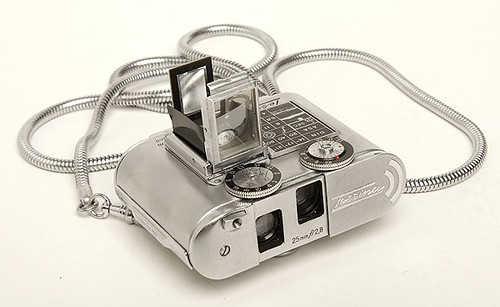Difference between revisions of "Tessina"
(date) |
m (date disagreement) |
||
| Line 6: | Line 6: | ||
|image_text= Tessina<br /><small>By Rick Soloway</small> | |image_text= Tessina<br /><small>By Rick Soloway</small> | ||
}} | }} | ||
| − | The '''Tessina''' was a range of [[subminiature]] cameras made in Switzerland by Sigrist, and distributed by Concava S. A, from c.1960 for | + | The '''Tessina''' was a range of [[subminiature]] cameras made in Switzerland by Sigrist, and distributed by Concava S. A, from c.1960 for around four decades<ref>{{McKeown}} p.210; <a href="http://en.wikipedia.org/wiki/Tessina">Wikipedia</a> quotes 1957-96, but is unreferenced.</ref>. For a subminiature, it had three unusual features: it used [[35mm film]] in special cassettes, running across the bottom of the camera - at a right-angle to the lens axis; it had spring motor [[film advance]], and was a [[TLR]]. There were there models, the 35, 35 Auto and 35L. The L model had the lens mounted on the top, in place of the finder, perhaps intended for use covertly. |
It had a Tessinon 25mm f2.8 lens, set in 1/2-1/500s shutter on a metal body with rounded ends, measuring approx 69x56x27mm (2½x2¼x1 inch). The top carried the two-frame flip-up viewfinder; under the frame finder was a reflex, waist-level finder - making it a [[TLR]]. An accessory magnifier was available for the tiny reflex screen. The lenses had a sliding cover for protection. The top also had an exposure table, and the focus and aperture dials. The aperture dial has the frame counter fitted on top. The shutter speed is set on a dial at the back. | It had a Tessinon 25mm f2.8 lens, set in 1/2-1/500s shutter on a metal body with rounded ends, measuring approx 69x56x27mm (2½x2¼x1 inch). The top carried the two-frame flip-up viewfinder; under the frame finder was a reflex, waist-level finder - making it a [[TLR]]. An accessory magnifier was available for the tiny reflex screen. The lenses had a sliding cover for protection. The top also had an exposure table, and the focus and aperture dials. The aperture dial has the frame counter fitted on top. The shutter speed is set on a dial at the back. | ||
| Line 19: | Line 19: | ||
* [http://www.cameraquest.com/tessina.htm Tessina on Cameraquest] | * [http://www.cameraquest.com/tessina.htm Tessina on Cameraquest] | ||
* [http://www.submin.com/35mm/collection/tessina/introduction.htm Tessina on Submin.com] | * [http://www.submin.com/35mm/collection/tessina/introduction.htm Tessina on Submin.com] | ||
| + | * [http://www.johnandlisa.us/john/tessina-notes.html Tessina, by John Lehman] | ||
| + | * [http://v3.espacenet.com/publicationDetails/mosaics?CC=AT&NR=246552B&KC=B&FT=D&date=19660425&DB=&locale= Austrian Patent] (in German) from 1966 seems to refer to the Tessina. | ||
[[Category: T]] | [[Category: T]] | ||
Revision as of 01:32, 15 November 2009

|
| Tessina By Rick Soloway |
The Tessina was a range of subminiature cameras made in Switzerland by Sigrist, and distributed by Concava S. A, from c.1960 for around four decades[1]. For a subminiature, it had three unusual features: it used 35mm film in special cassettes, running across the bottom of the camera - at a right-angle to the lens axis; it had spring motor film advance, and was a TLR. There were there models, the 35, 35 Auto and 35L. The L model had the lens mounted on the top, in place of the finder, perhaps intended for use covertly.
It had a Tessinon 25mm f2.8 lens, set in 1/2-1/500s shutter on a metal body with rounded ends, measuring approx 69x56x27mm (2½x2¼x1 inch). The top carried the two-frame flip-up viewfinder; under the frame finder was a reflex, waist-level finder - making it a TLR. An accessory magnifier was available for the tiny reflex screen. The lenses had a sliding cover for protection. The top also had an exposure table, and the focus and aperture dials. The aperture dial has the frame counter fitted on top. The shutter speed is set on a dial at the back.
Frame size is 14x21mm - smaller than a standard half-frame camera, but larger than many subminiatures. A daylight loader was available to load the cassettes with about 14-20 inches of standard 35mm film, giving between 20 and 30 frames per cassette.
- ↑ McKeown p.210; <a href="http://en.wikipedia.org/wiki/Tessina">Wikipedia</a> quotes 1957-96, but is unreferenced.
Links
- Tessina on subclub.org
- Tessina on Cameraquest
- Tessina on Submin.com
- Tessina, by John Lehman
- Austrian Patent (in German) from 1966 seems to refer to the Tessina.